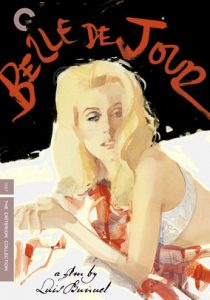Belle De Jour-1967
Director Luis Buñuel
Starring Catherine Deneuve, Jean Sorel
Scott’s Review #486
Reviewed September 29, 2016
Grade: A
Belle De Jour, the title translates to “lady of the day”, a French pun for “lady of the night”, a kind phrase for prostitution, is a fantastic art film.
Stylish, sophisticated, and open to interpretation (at least in my opinion), Belle De Jour is a late 1960s journey into eroticism, social norms, and sexual freedom.
Gorgeous star Catherine Deneuve has never looked better and calmly does mental conflict.
Luis Buñuel directs the film.
Severine is a wealthy, young, newlywed who seemingly has it all. She is showered with love and affection, not to mention material items, by her handsome hubby, Pierre, played by dashing Jean Sorel.
She wants for nothing as her husband is a doctor of great wealth. Yet she is unhappy and refuses to have physical relations with Pierre.
She begins a secret life as a prostitute in a posh home, only working in the afternoons, to avoid being found out. She has no regrets but is apprehensive about the clients she meets.
Throughout the film, Severine has secret fantasies about being kept in bondage and enduring various other sexual humiliations. All the while, the question is, “Is this all Severine’s fantasy or reality?” Or perhaps merely a portion is.
The audience wonders.
Do we feel sorry for the character of Severine? Not. One could argue that she is spoiled and selfish, but she is not evil; she is somewhat confused. She is quite polite, and Deneuve fills her with kindness and even an angelic spirit.
One cannot despise her, even though on the surface one might be tempted to. What right does this woman have to rebuff her husband in place of sleazy clients? One particularly volatile client becomes obsessed with Severine and stalks her, going so far as to exact violence against her husband.
But wait, is this Severine’s fantasy or reality? Is she imagining everything and merely obediently waiting at home for her husband to return each day, or is she living this life?
Buñuel uses many shots of gorgeous Paris, including the famed Arc de Triomphe and other interesting streets and sights, which is a treat for culture fans. The use of these exteriors goes a long way to ensure that the film is clearly “French” from a visual perspective.
Indeed, in 1967, the sexual revolution was in full swing, and Belle De Jour epitomized the revolution of the times. Yet, it does not feel dated or reduced to a film “of its time”.
I find it more of a character study than a genre film, as Severine is an interesting study.
Belle De Jour challenges the viewer with an intense yet subtle story of a woman conflicted with sexual desire and repression- a film open to much interpretation and discussion.
It does what an art film is supposed to do- makes us think and ponder.
